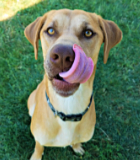Teaching Your Dog to Stay
- This topic has 0 replies, 1 voice, and was last updated 14 years, 10 months ago by
Mackenzie’s Admin.
-
AuthorPosts
-
June 17, 2010 at 5:17 pm #541
Mackenzie’s Admin
MemberOnce your dog has mastered sit or down on cue, you’re ready for the next step: teaching her to stay on cue. She will learn that when you say “Stay,” she should maintain whatever position she is in (a sit or a down, for example) until you release her with another cue. So to teach stay, you’ll need to teach your dog two verbal cues: “Stay” for when to hold still and “OK” (or whatever release word you choose) for when she can move around again.
The stay is quite useful, but keep in mind that it’s challenging for dogs to learn. Use high-value rewards like boiled chicken, low-fat cheese, bits of sliced hot dog and freeze-dried liver. When teaching your dog the stay, you’re asking her to do a hard job that doesn’t make much sense to her. You’re asking her to stay somewhere while you leave her side, which is something dogs never ask of each other unless they don’t particularly like each other. So reward her well!
How to Teach Stay
Like children, dogs learn best when we break down skills into small, easy steps. You need to start out slowly by training a simple version. Then you can gradually make the behavior more and more difficult. Following are guidelines for how to teach your dog to stay in a down position (down-stay), but you can use the same method to teach your dog to remain in any position, like sit or stand.At each of these small steps, you’ll teach your dog to master three different aspects of stay: the length of the stay (duration), how far away you are from your dog (distance) and what’s going on around your dog (distraction). The key is to train only one aspect at a time. In fact, while you are working on any one of those three aspects, you should make the other two easier for your dog. For instance, if you’ve already taught your dog to stay for 15 seconds (duration), and you start to work on moving away from her (distance), only ask her to stay for five seconds as you increase the distance you are away from her. Once she shows you she can stay while you are five feet away, work to increase the time to 15 seconds again. Next, add distractions. To do that, go back to standing no more than three feet in front of her for 5 to 10 seconds while you have someone walk behind you or her (for a dog, someone walking by is a distraction).
Prepare for Training
First, make sure that your dog already understands down and will lie down readily when you give her the cue or a hand signal.
Put a bunch of small (dime-sized), delicious treats in your pocket or a pouch and find a quiet place to train where your dog won’t be easily distracted.
Choose a word or phrase to end the stay, such as “OK,” “Free” or “All Done!”Stage One: Duration
Your goal: Teach your dog that staying down pays off.Stand right in front of your dog and say “Down.” Immediately after your dog lies down, say “Stay,” and then give her the stay hand signal: an open palm in front of her nose.
Immediately say “Good!” and deliver a treat. Then, as long as your dog doesn’t move, immediately say “Good!” again and give your dog another treat.
Pause for one second and then say “OK” (or whichever release word you chose). Then ignore your dog for a few seconds, until she gets up from the down position.
Repeat this exercise, slowly stretching out the time that your dog must stay between each “Good” and your delivery of a treat. Remember to go slowly. First ask your dog to stay for two seconds. Then increase to five seconds. Then try for ten seconds, then 15, then 25, etc. Continue randomly rewarding your dog as long as she’s in the stay.Stage Two: Distance
Your goal: Teach your dog to stay while you move away from her.After you and your dog have mastered stage one, you can start to move around and away from your dog. Remember to progress slowly, which helps your dog to succeed. Don’t ask your dog to stay and then run to the other side of the room. Start by moving only one step away.
As before, say “Down.” After your dog lies down, say “Stay” and give her the stay hand signal.
Take one step backwards. Immediately say “Good!” and quickly step back toward your dog to deliver her treat. Then pause for a second or two and give your dog her release word (e.g., “OK”). Let her move around for a few seconds. Then repeat the exercise. Aim for at least 10 repetitions per training session.
Gradually increase the number of steps you move away from your dog, always coming back to her to deliver goodies while she holds the stay. Remember to end the stay by saying “OK” to release her and not to just let her move when you say “Good” or when you give her the treat.As you take more steps away from your dog, you can start to increase the time you ask your dog to stay while you’re away from her. During the stay, return to your dog periodically to give her treats. For example, take two steps away from your dog, pause for three seconds, say “Good” and return to give her a treat, take two steps away from your dog again, pause for three seconds, return to reward, pause again, and then release your dog.
Stage Three: DistractionYour goal: Teach your dog to stay in different places.
After you teach your dog to stay in familiar and quiet places, you’ll need practice stay in busier places too. Because your dog will find holding a stay in new and distracting places difficult, you’ll start with very short, easy stays.
First, practice the stay in different rooms of your house. Don’t ask your dog to stay for very long, and don’t move very far away from her.
When your dog successfully stays all over your house when it’s quiet, try practicing with another person or two present.
Move outside, to your front or backyard to practice.
Gradually move to more distracting places. Eventually you can practice while on walks, in the park and even around other dogs!Points to Keep in Mind As You Train
Always use your release word. If you forget to use it, your dog will learn that she can just break the stay on her own, without waiting for permission.
If your dog breaks the stay before you release her, immediately say something like “Nope!” or “Oops!” Then say “Down” and “Stay” again to get her back into position. If she stays for a few seconds, say “Good” and give her a treat or praise her, and then release her. This teaches her the difference between staying until you release and moving on her own. On your part, make a mental note: you’ve progressed too fast. Go back to practicing easier stays for a while.DO NOT punish your dog if she breaks the stay before you release her. Hitting, yelling or jerking her leash won’t help her learn. Your dog isn’t disobeying you. She just doesn’t understand the exercise yet.
Avoid repeating “Stay” during the training exercise. Just say the cue once.
If your dog seems reluctant to lie down on an uncomfortable surface, use a dog bed or soft mat during your training sessions.After your dog has mastered the stay with you, she won’t automatically understand how to perform the stay for others, so make sure she practices with everyone in your family. New people will need to teach stay from the beginning, but your dog will learn faster with each new person.
Final Tips
To learn more about how to teach your dog new things, please see our article, Training Your Dog.If you’d like help teaching your dog to stay—or if you’d like to learn how to train additional useful skills—consider contacting a Certified Professional Dog Trainer (CPDT) in your area. Many CPDTs offer private lessons and group obedience classes that focus on fun, effective training methods. Please see our article, Finding Professional Help, to locate a CPDT near you.
-
AuthorPosts
- You must be logged in to reply to this topic.












































